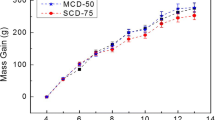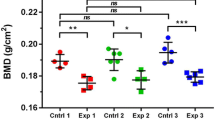Abstract
The effects of 5, 10, and 20% dietary xylitol supplementations on the resorption of bone were studied. The resorption was measured by the urinary excretion of [3H] radioactivity from [3H]tetracycline-prelabeled rats. The 10 and 20% oral xylitol administrations caused a significant decrease in the excretion of [3H] as compared with the control group with no xylitol supplementation. The effect was detected as early as 2 days after the beginning of xylitol-feeding and was maintained throughout the experimental period of 31 days. The retarding effect on bone resorption was about 25% in the 10% xylitol group, about 40% in the 20% xylitol group, and undetectable in the 5% xylitol group. The amount of preserved [3H] radioactivity in the tibiae of the 10 and 20% xylitol groups after the experiment clearly exceeded the valties of the control group. The mechanism of the retarded bone resorption caused by dietary xylitol still remains obscure, but an increased absorption of calcium may be involved. In conclusion, dietary xylitol supplementation in rats seems to retard the bone resorption in a dose-dependent way. The effect is achieved rapidly and is maintained at least over a period of 1 month xylitol feeding.
Similar content being viewed by others
References
Washüttl J, Riederer P, Bancher E (1973) A qualitative and quantitative study of sugar-alcohols in several foods. J Food Sci 38:1262–1263
Touster O (1969) The uronic acid pathway and its defect in essential pentosuria. In: Horecker BL, Lang K, Takagi Y (eds) International symposium on metabolism, physiology, and clinical use of pentoses and pentitols. Springer-Verlag, Berlin, New York, p 79
Bässler KH, Prellwitz N, Unbehaun V, Lang K (1962) Xylitsoffwechsel beim Menchen. Zur Frage der Eignung von Xylit als Zuckersatz beim Diabetiker. Klin Wochenschr 40:791–793
Mäkinen KK (1978) Biochemical principles of the use of xylitol in medicine and nutrition with special consideration of dental aspects. Experientia (suppl) 30:1–160
Wang Y-M, vanEys J (1981) Nutritional significance of fructose and sugar alcohols. Annu Rev Nutr 1:437–475
Hämäläinen MM, Mäkinen KK, Parviainen MT, Koskinen T (1985) Peroral xylitol increases intestinal calcium absorption in the rat independently of vitamin D action. Miner Electrol Metab 11:178–181
Angyal SJ (1974) Complexing of polyols with cations. Tetrahedron 30:1695–1702
Knuuttila M, Svanberg M, Hämäläinen M (1989) Alteration in bone composition related to polyol supplementation of the diet. Bone Miner 6:25–31
Hämäläinen M, Knuuttila M, Svanberg M, Koskinen T (1990) Comparison of the effect of gluconate, lactose and xylitol on bone recalcification in calcium-deficient rats. Bone 11:429–438
Knuuttila M, Svanberg M (1992) Preventive effect of xylitol on bone Ca in ovariectomized rats. Connect Tissue Res 27:176
Arends J, Christoffersen J, Schuthof J, Smits MT (1984) Influence of xylitol on demineralization of enamel. Caries Res 18: 296–301
Smits MT, Arends J (1988) Influence of extraoral xylitol and sucrose dippings on enamel demineralization in vivo. Caries Res 22:160–165
Raisz LG, Trummel CL, Holick MF, DeLuca HF (1972) 1,25-dihydroxy-cholecalciferol: a potent simulator of bone resorption in tissue culture. Science 175:768–769
Ibsen KH, Urist MR (1964) The biochemistry and the physiology of the tetracyclines. Clin Orthop 32:143–168
Frost HM (1965) Tetracycline and fetal bone. Henry Ford Hosp Med Bull 13:403–410
Mühlbauer RC, Fleisch H (1990) A method for continual monitoring of bone resorption in rats: evidence for a diurnal rhythm. Am J Physiol 259:R679-R689
Klein L, Jackman KV (1976) Assay of bone resorption in vivo with 3H-tetracycline. Calcif Tissue Res 20:275–290
Klein L, Wong KM (1986) Effect of calcium deficiency upon the loss of 3H-tetracycline and 13C-collagen from bone of prelabelled rats. Bone 7:392–393
Klein L, Wong KM, Simmelink JW (1985) Biochemical and autoradiographic evaluation of bone turnover in prelabelled dogs and rabbits on normal and calcium-deficient diets. Bone 6:395–399
Altman DG (1990) Practical statistics for medical research. Chapman and Hall, London, pp 426–433
Mäkinen KK (1976) Long-term tolerance of healthy human subjects to high amounts of xylitol and fructose: general and biochemical findings. In: Ritzel G, Brubacher G (eds) Monosaccharides and polyalcohols in nutrition, therapy and dietetics. Huber, Bern, p 92
Kelly RG, Buyske DA (1960) Metabolism of tetracycline in the rat and the dog. J Pharm Exp Ther 130:144–149
Klein L, Reilly DT (1976) Concurrent exchange of 45Ca and 3H-tetracycline from rat bone in vitro. Calcif Tissue Res 20:229–234
Nordin BEC, Morris HA (1989) The calcium deficiency model for osteoporosis. Nutr Rev 47:65–72
Author information
Authors and Affiliations
Rights and permissions
About this article
Cite this article
Mattila, P., Svanberg, M. & Knuuttila, M. Diminished bone resorption in rats after oral xylitol administration: A dose-response study. Calcif Tissue Int 56, 232–235 (1995). https://doi.org/10.1007/BF00298616
Received:
Accepted:
Issue Date:
DOI: https://doi.org/10.1007/BF00298616




